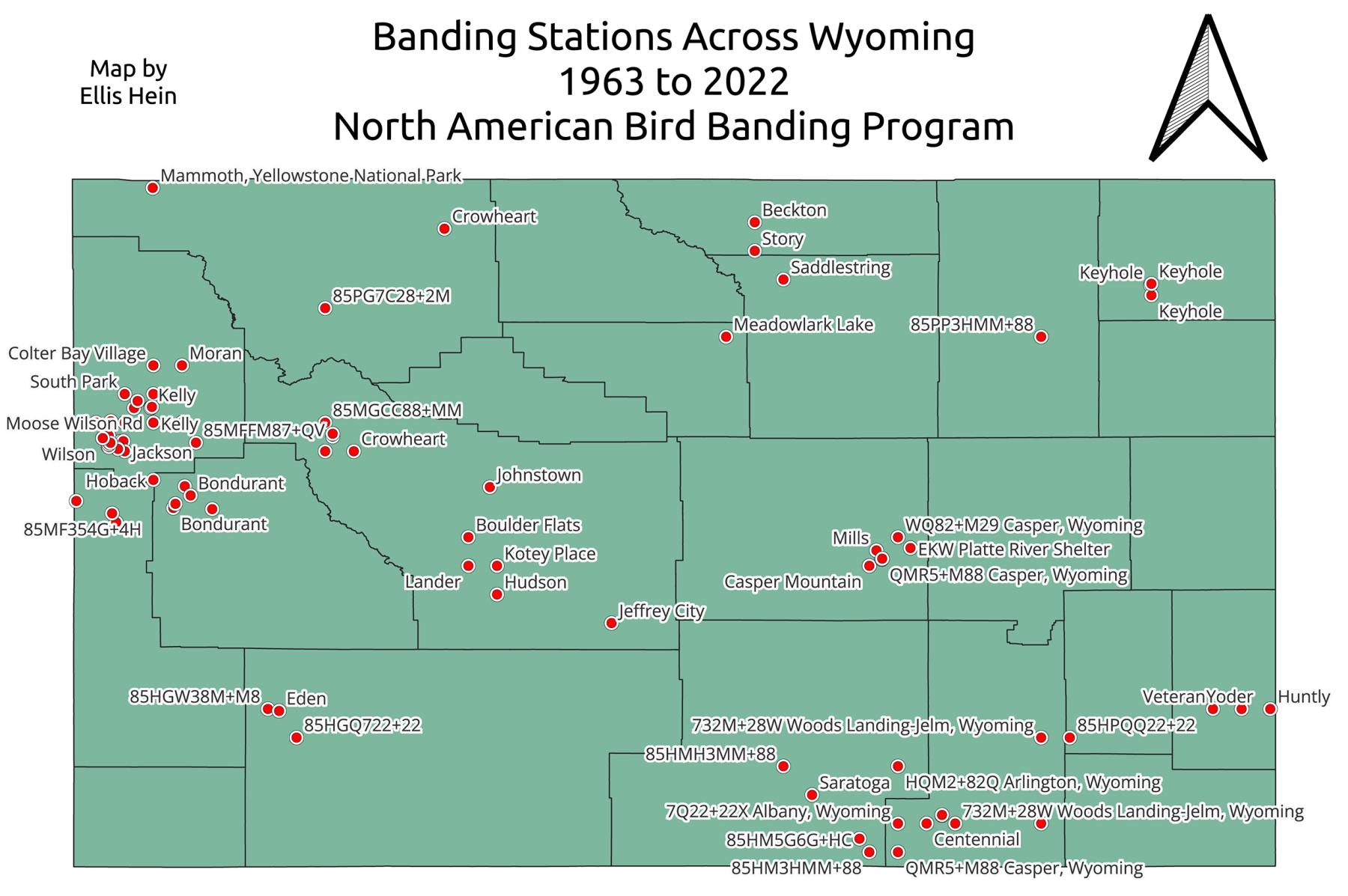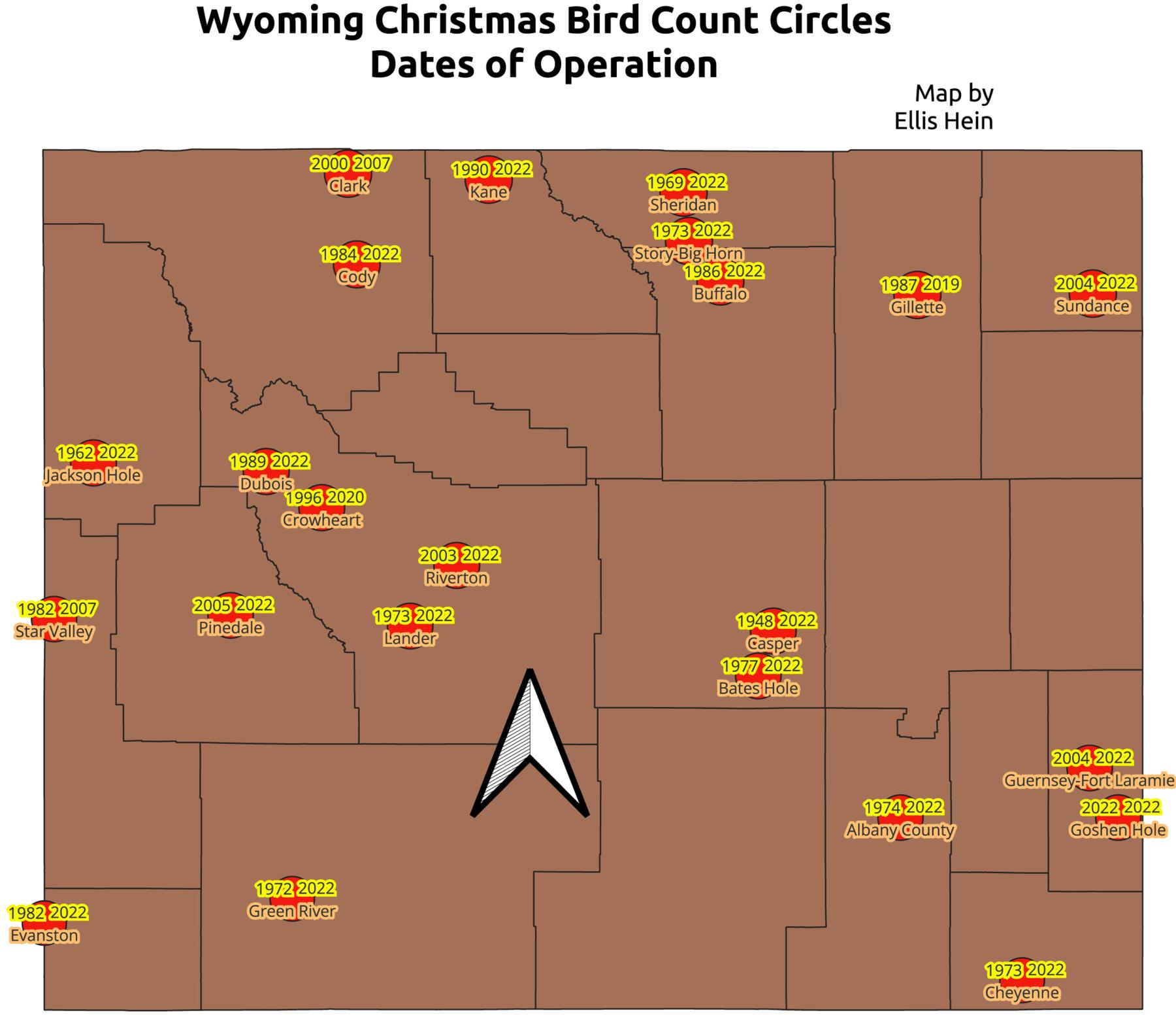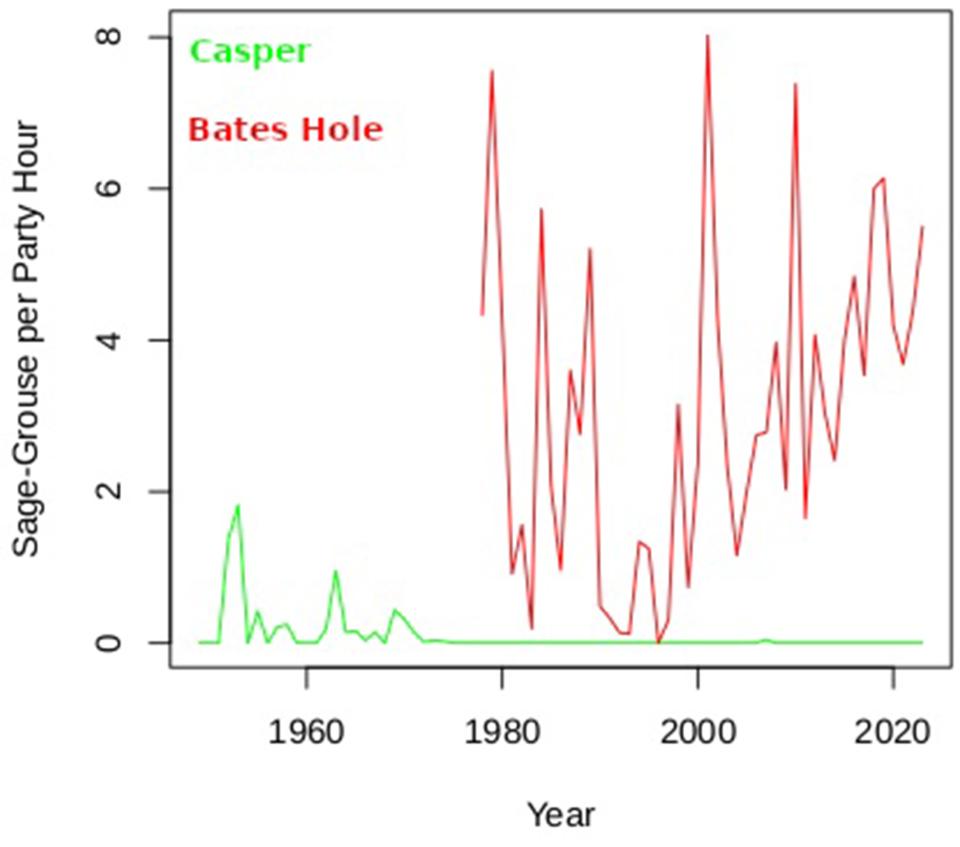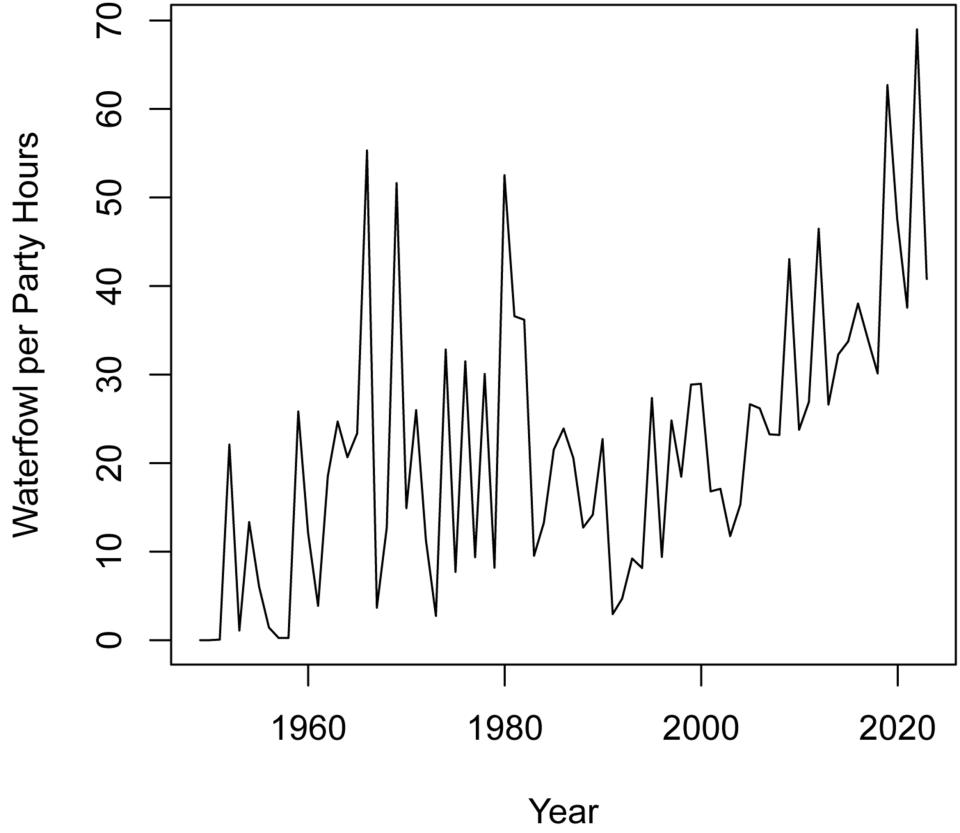- Home
- Encyclopedia
- Tracking Wyoming’s Birds
Tracking Wyoming’s Birds
You Never Know
It was Jan. 1, 1983. The place was Bates Hole, a sagebrush expanse south of Casper and south of Casper Mountain in Wyoming; the occasion, the annual Christmas bird count. Birders Charlie Scott and Frank Odasz had spotted a rough-legged hawk or a prairie falcon—sources differ—that dropped a rare bird—a Virginia rail. Charlie captured it alive. When he returned to his Two Bar Ranch house at the end of the day for the tally session, Charlie put the rail in a shoe box in the back room. Everyone except Charlie’s father, Dr. Oliver Scott, knew what was coming.
Image
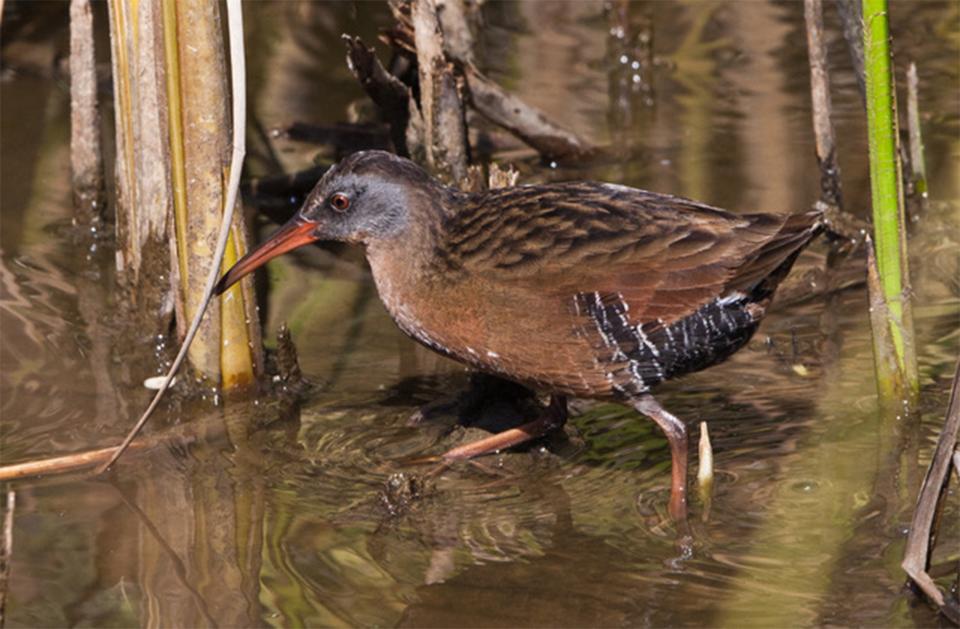
Oliver was the acknowledged authority on Wyoming birds. When Dr. Scott, a pediatrician, was running the Casper and Bates Hole Christmas bird counts, if you had an unusual bird, you had to be prepared to defend your identification with field marks and details of plumage. Field marks can include wing bars, eye rings, tail length, etc. So on this occasion, per the routine, after going through all the usual birds Dr. Scott asked if anyone had any birds not on the list.
Charlie said, offhand, “Virginia rail.”
“What,” exploded Dr. Scott, “What did you really see?” So Charlie produced the shoe box and showed his father, who exclaimed, “My God, it’s a Virginia rail!” The rail survived the winter to be released back into the wild the next spring.
A ring-necked pheasant? There it was, unmistakable right beside the car. Pheasants first showed up in the Bates Hole Christmas count in 1984 and became more common from 2005 on. But the first time I’d seen a ring-necked pheasant in Wyoming was on the 2023 Bates Hole count.
During the 2023 Casper Christmas count, I was leaning against the car waiting for J.P. Cavigelli to return from counting his portion of Dirty Shirt Woods. Dirty Shirt is south of Coal Mountain, which is west of Casper Mountain. I heard footsteps and, assuming it was J.P., without turning around I asked what he had found. But it was a young man from Minnesota. This was also the first time I found a Minnesotan on a bird count. They may be as scarce as Virginia rail or as numerous as ring-necked pheasant, but they don’t count.
My point has to do with the unpredictability and adventure of Christmas bird counts. You never know what you’ll find.
Why count birds?
What is this about? Throughout many years, why do people spend a winter day driving and walking in all kinds of weather to count birds?
A recent headline of the American Bird Conservancy ran “3 Billion Birds Gone.” They referred to a 2019 research article by Kenneth V. Rosenberg et al., which reported on declining bird populations across North America during the last half century.
We can say, “Let’s look at what’s happening in Wyoming.” But that is harder than it sounds. There are only a few birds of which we can say, “These are Wyoming birds.” Most of “our” birds spend most of their lives outside Wyoming. They may travel each year to South America and back. The birds visiting your feeder during the winter might come from northern Canada. Birds pause in Wyoming during spring and fall migration. Only some of the birds we see are year-round residents. How can we measure what’s happening? And how long have people been actively trying to conserve bird populations in Wyoming?
Image
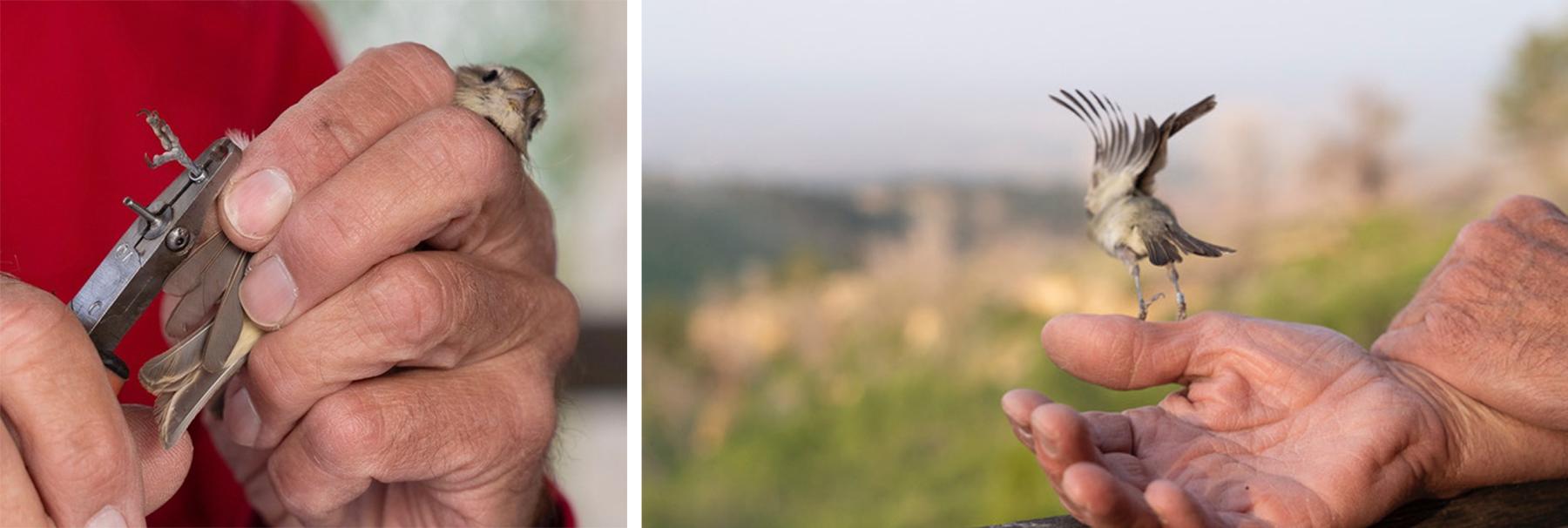
Techniques
Birders can survey breeding populations by using breeding-bird spot counts and, during nesting season, banding birds. Surveyors perform yearly spot counts in given locations; the protocol requires a five-minute stop every half mile during which you count every species and number of birds you see or hear. Banding also consists of following a given procedure for a given protocol.
The Monitoring Avian Production and Survivorship (MAPS) protocol, for example, requires each mist net to be set up in the same location each year. A mist net has threads so fine that it looks like a faint mist. Birds usually don’t see the net and are caught when they fly into it. For useful data, the station must run a minimum number of net hours each time. Throughout breeding season, banders set up the nets on average 10 days apart. Birders extract the birds from the net, band them and collect vital data, then release them.
Each band is a lightweight metal strip with a unique series of numbers stamped into it. This is carefully placed on the bird’s leg, recorded along with all data collected and submitted to the Bird Banding Laboratory. Breeding birds return to the same locale each year, so recaptured birds begin to generate a picture of how many adults and how many chicks have survived from year to year. From at least 1962 to the present, a number of Wyoming banding sites have been active. Going by unique latitude and longitude location, I have found 93 stations that submitted data on yellow warblers over the years. If you go by place names, that number drops to 57 with some stations recording one year of data only. Some places, South Park for example, had several locations, yet each with the identical name.
Birders conduct migration surveys by migration banding and using weather radar. Yes, NEXRAD (NEXt generation RADar), the same technology that tells you a storm is approaching, can count birds. For example, https://dashboard.birdcast.info/region/US-WY?night=2023-09-13 indicated that on the night of Sept. 13-14, 2023, 34,075,900 birds were flying over Wyoming. Of those, 10,646,600 went all the way across Wyoming, leaving about 23 million birds in the state resting and feeding to prepare for the next push south. People on the ground doing survey counts and migration banding use this information to focus their efforts.
Christmas bird counts monitor winter populations. Birders conduct these each year from Dec. 14th to Jan. 5th. On the given day, a dozen or two participants divide up places to check inside a 15-mile diameter circle, spending eight to 12 hours in the field. They then report the species and number of birds counted plus the number of party hours invested. Regardless of whether there are two, three, or, say, five people in the party, if they count birds for three hours, that counts for three party hours spent on the bird count. This data is sent to the National Audubon Society to be compiled and published.
How long have Wyomingites been involved?
High-tech tools do not preclude dedicated people on the ground. One such person is Hustace (Stacey) Scott, whose father, Oliver, organized the Casper Christmas bird count in 1948. This count took place on the first day of the Blizzard of 1949. Stacey says he was in on that count even though he was just a few months old. He has probably been interested in birds ever since.
Stacey has been instrumental in many bird conservation efforts. He has done yearly spot counts, breeding bird surveys, sage-grouse lek counts, banding of songbirds, Christmas bird counts and more. A lek is a specific place where the cocks gather each spring to strut, to attract hens. He stated that once he was old enough to work on the ranch, he got three days off annually: one day each for the Casper and Bates Hole counts, and the third for a Big Day organized by Bart Rea, a long-time local birder. These were fundraisers for the local Audubon chapter. On Big Day, birders dedicate 24 hours to travel and counting birds to see how many individuals and species they can find. For Stacey, all other conservation work had to mesh with the duties of the ranch.
I asked Stacey what changes he had observed since he was old enough to remember participating in bird counts.
In the winter in the 1950s Charlie Scott recalls he could step from rock to rock across the North Platte River in the Casper area wearing just overshoes. That is, the water was too low in winter to attract waterfowl at the time of Christmas bird counts. Completion of Gray Reef Dam a few miles below the much larger Alcova Dam in 1961 guaranteed a flow past Casper of at least 400 to 500 cubic feet per second year round; enough for ducks, geese and other waterfowl. Those numbers, therefore, are up.
Irrigation across Wyoming has benefited farmers and ranchers. But the cost has been loss of habitat to species like greater sage-grouse and brewer’s sparrow, which depend on the sagebrush ecosystem. Greater sage-grouse habitat has shrunk to approximately 56 percent of its historical range in North America. Due to the loss of habitat, sage-grouse numbers are declining. Of the remaining population, 37 percent is in Wyoming.
Mice and rabbits increased when sagebrush land became irrigated fields. This in turn increased populations of hawks and eagles. Songbirds that do not depend upon sagebrush and that can co-exist with the haying or cultivation schedule also became more common. Lesser goldfinch, for example, which feed on thistle seed, wild lettuce seed and sunflower seed appeared in the Casper area in 1989.
Greater sage-grouse are counted two different times. The Wyoming Department of Game and Fish sponsors a lek count each spring. Though the cocks are relatively easy to count, hens blend into sagebrush and can remain hidden. Greater sage-grouse are also counted during Christmas bird counts, which should show similar trends. When they don’t, we have to wonder why. Stacey reported that recent lek count numbers in Bates Hole are down while Christmas bird count sage-grouse numbers are up.
To understand the impact of habitat loss, birders compare sage-grouse data from inside the 15-mile-diameter Casper circle with data from the Bates Hole circle. The Casper circle includes areas with habitat lost to development and irrigation. There is some irrigation in the Bates Hole Circle, but a much larger portion is still sagebrush. In the last 50 years, six sage-grouse have been counted in the Casper circle: one in 1973 and five in 2006. The Bates Hole Christmas count, for 1977 to 2022, totals 4,238 sage grouse. The Bates Hole numbers fluctuate more or less according to the normal 10-year cycle of decline and increase.
Good-humored rivalry
While the goal of all this effort is to accumulate data, it is not all drudgery.
On the 2000 Bates Hole Christmas bird count, Stacey and Frank Odasz were counting waterfowl in the Lusby Landing area on the North Platte, about 28 miles south of Casper. Stacey walked up the river while Frank drove ahead to Lusby. Stacey was having a really good day. He had found Wilson’s snipe, great blue heron and female pintail. After he and Frank met, they walked around the next corner and found white pelican. “You can’t get better than this,” Stacey told Frank. “Are you sure you can’t get better than this?” asked Frank, knowing what was ahead. Around the next bend were four trumpeter swans, the first ever identified in Natrona County.
What banding data tells us
Let’s switch from winter to late spring/early summer and instead of open country imagine we are in the city. In the country you see insects flying around and might see flashes of yellow darting in and out of the foliage—almost certainly yellow warblers. In the city, the birding enthusiast might ask, “Why do I not have yellow warblers here in my yard? I have abundant vegetation of all the right sorts.” Like all warblers, the yellow warbler’s principal food is insects. Cities that, like Casper, systematically spray insecticides to keep mosquito populations low create famine for insect-eating birds; they go elsewhere. The problem is that “elsewhere” is diminishing.
We can call yellow warblers a “typical insect-eating bird.” Compare banding data from three MAPS stations in Wyoming: one at Keyhole State Park in the northeast part of the state, one at Edness Kimball Wilkins State Park east of Casper and one at Centennial, south of Laramie. This graph covers 2005 through 2022. You see populations declining and rebounding. But where one station shows decline others do not, until we get to the peaks at 2015 to 2017. Should we be concerned that all three stations show a decline at the end of the data?
History is a living thing; each year puts down a new layer. Each layer offers a rich diversity of information—all intertwined. It is short-sighted and perhaps disastrous to view history as only human events. The mid-20th century naturalist Aldo Leopold wrote: “[Our] appreciation of the [sandhill] crane grows with the slow unraveling of earthly history. His tribe, we now know, stems out of the remote Eocene. The other members of the fauna in which he originated are long since entombed within the hills. When we hear his call we hear no mere bird. We hear the trumpet in the orchestra of evolution. He is the symbol of our untamable past, of that incredible sweep of millennia which underlies and conditions the daily affairs of birds and men.”
Step with me into a science fiction scenario for a moment. Birds and humans have changed positions with birds now the dominant species. In our fantasy world, birds are treating humans like we have been treating them—dispensable. Look now at the headline referred to at the beginning of this article. It would read: “3 Billion Humans Gone.”
But that isn’t so far-fetched. Here is where fantasy and reality merge. Hordes of insects can and do wipe out entire crops, creating famine for humans. We blithely try to control insects with chemicals, but insects evolve rapidly and soon become immune to our poisons. But birds do control insect populations. A mosquito, for example, has never become immune to a hungry warbler or a violet-green swallow.
The efforts of all the people across Wyoming who have spent lifetimes studying and monitoring bird populations has been to this one end: Preserve history. Save the birds. We depend on them.
Image
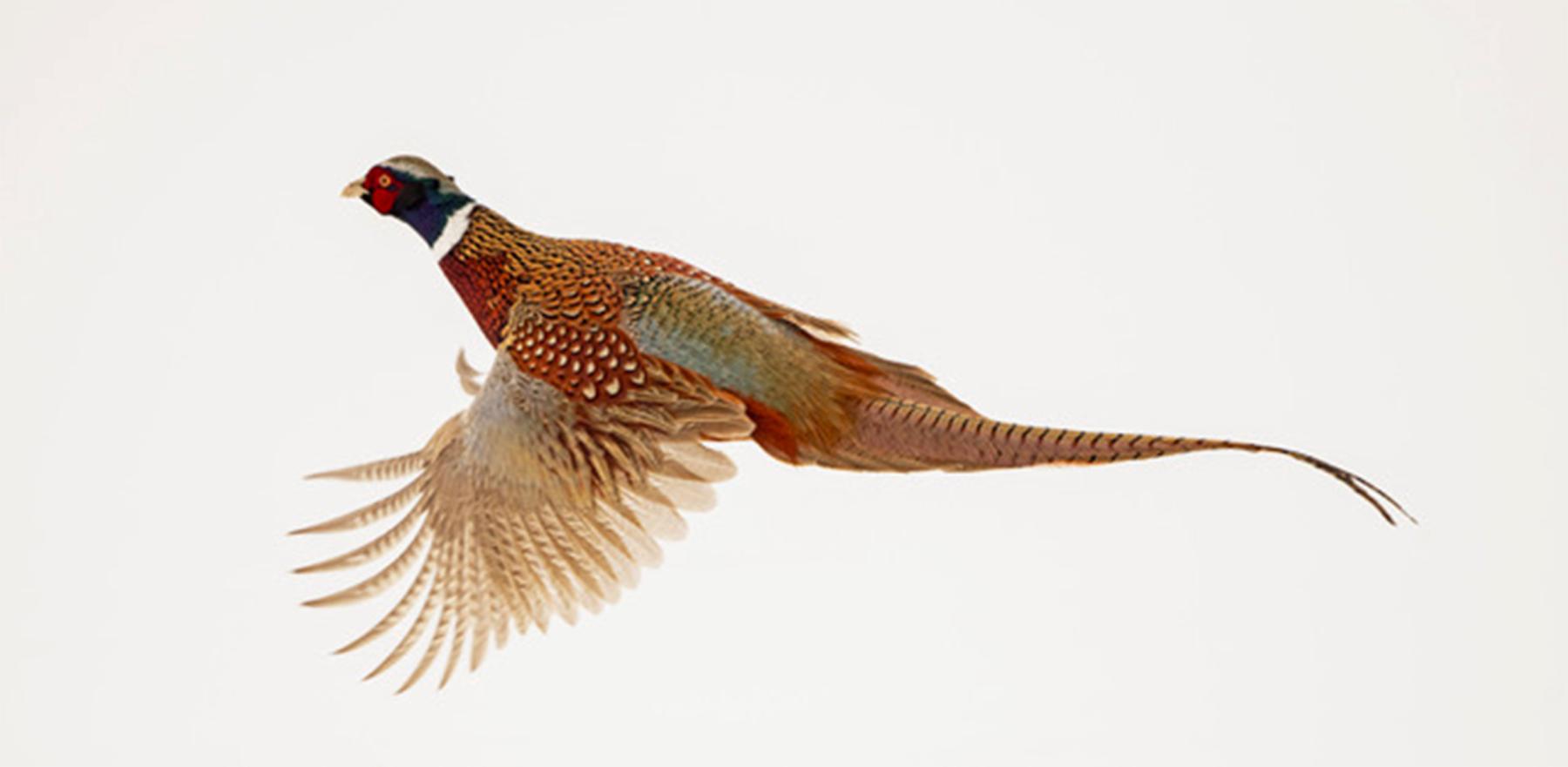
Resources
Primary Sources
- Scott, Charlie. Interview with author, Jan. 1, 2024.
- Scott, Stacey. Interview with author, Nov. 13, 2023.
Secondary Sources
- American Bird Conservancy. “3 Billion birds Gone,” accessed Jan. 4, 2024 at https://abcbirds.org/3-billion-birds/.
- Audubon Christmas Bird Count, accessed Jan. 4, 2024 at https://netapp.audubon.org/CBCObservation/Historical/ResultsByCount.aspx.
- BirdCast, accessed Jan. 4, 2024 at https://dashboard.birdcast.info/region/US-WY?night=2023-09-13.
- Ecological Data Wiki, Christmas Bird Count, accessed Jan. 4, 2024 at https://ecologicaldata.org/wiki/christmas-bird-count.
- Edmunds, David R., Cameron L. Aldridge, Michael S. O’Donnell, Adrian P. Monroe. “Greater Sage-Grouse Population Trends Across Wyoming,” Journal of Wildlife Management 82, no. 2 (February 2018) Special Section: Celebrating Waterfowl Conservation, 397-412, accessed Dec. 5, 2023 at https://www.jstor.org/stable/26608878. Available to patrons at Natrona County Public Library.
- Leopold, Aldo. A Sand County Almanac and Sketches Here and There. London: Oxford University Press, 1949, 96.
- Nakash, E., M. Malorodova, L. Howes, A. Celis-Murillo. North American Bird Banding Program Dataset 1960-2023 (July, 12, 2023). U.S. Geological Survey, accessed Jan. 4, 2024 at https://www.sciencebase.gov/catalog/item/653fa806d34ee4b6e05bc57d.
- Platte River Basin Water Atlas, accessed Jan. 4, 2024 at https://waterplan.state.wy.us/plan/platte/2006/atlas/pathfinder/pathfinder_agricultural_irrigation_districts.htm.
- Rosenberg, Kenneth V., Adriaan M. Dokter, Peter J. Blancher, John R. Sauer, Adam C. Smith, Paul A. Smith, Jessica C. Stanton, Arvind Panjabi, Laura Helft, Michael Parr, Peter P. Marra. “Decline of the North American avifauna.” Science (Oct. 4, 2019), 120-124, accessed Jan. 4, 2024 at https://dariuszzdziebk.wpenginepowered.com/wp-content/uploads/2019/10/Bird-Decline-paper_Science-formatted_final.pdf.
- Wyoming Game and Fish Department. “Dr. Oliver Scott Inducted into the [Wyoming Outdoor] Hall of Famie in 2015,” accessed Feb. 14, 2024 at https://wgfd.wyo.gov/Get-Involved/Outdoor-Hall-of-Fame/Dr-Oliver-Scott.
Illustrations
- The photos of the banding and release of a warbling vireo are by Evan Barrientos, from the author’s collection. Used with permission and thanks.
- The maps and graphs are by the author, used with permission and thanks.
- The photo of the pheasant is by birder Rob Koelling of Powell, Wyoming. Used with permission and thanks.
- The photo of the Virginia rail is by Mike Baird, via Wikipedia. Used with thanks.

